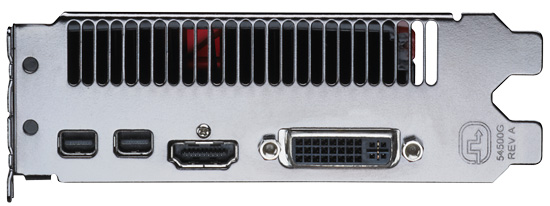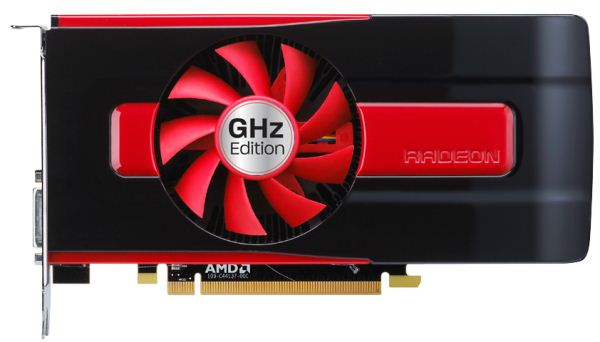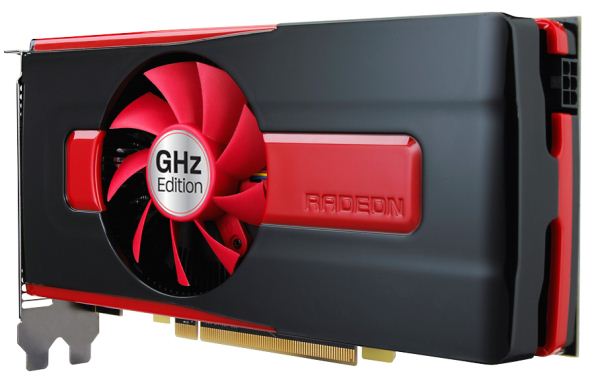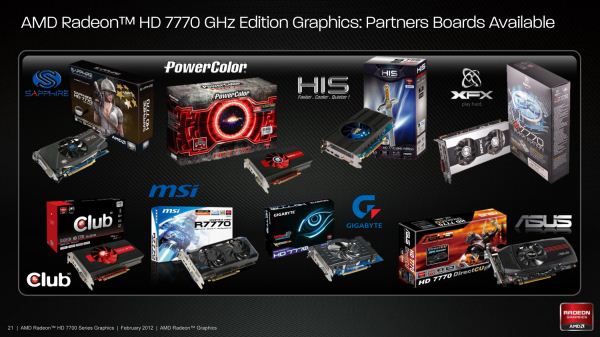AMD Radeon HD 7750 & Radeon HD 7770 GHz Edition Review: Evading The Price/Performance Curve
by Ryan Smith & Ganesh T S on February 15, 2012 12:01 AM EST- Posted in
- GPUs
- AMD
- HTPC
- GCN
- Radeon HD 7000
Meet the Radeon HD 7770 GHz Edition
The second card launching today is the Radeon HD 7770 GHz Edition. Compared to the 7750 it’s based on a fully enabled Cape Verde GPU and features a higher core clock of 1GHz, versus 800MHz on the 7750.
Starting as always with the cooler, for the reference 7770 AMD has gone with something that is best described as half of a blower. The shroud is completely enclosed on the sides, but due to the position of the fan the card exhausts hot air out of both the front and the rear of the card, which is something that’s common for dual-GPU cards such as the 6990 but atypical for a midrange video card. Heat transfer is provided by a basic black aluminum heatsink, while the fan is embedded in the middle of the heatsink.
As for the card itself, it’s effectively an extended version of the 7750. Like the 7750 the card is equipped with 4 256MB 5GHz Hynix GDDR5 RAM chips, along with some additional VRM circuitry to handle the higher 100W power limit for this board. External power is provided by a single 6pin PCIe power socket, while at the top of the card there is a single CrossFire connector. This is actually down from 2 connectors on the 5700 series, which comes as no great surprise as virtually no one ever used tri-CF with the 5700 series in the first place. Overall the card is 8.25” long with no notable shroud overhang, making it the same length as the 5770’s PCB.
Meanwhile for display connectivity AMD is using the same configuration as we’ve seen on the 7900 series: 1 DL-DVI port, 1 HDMI port, and 2 miniDP ports. Unlike the 7900 series AMD’s not requiring their partners to include any adaptors, so buyers with 2 DVI monitors will almost always be on their own. The presence of 2 miniDP ports means that the 7770 has quite a bit of flexibility in driving various displays, however as with the 7900 series if you want to drive more than 4 displays you will need a MST hub, the release of which is still some time off.

As for partner cards, as with the 7750 all of AMD’s partners are doing their own thing. No one will be using AMD’s reference cooler, though PowerColor in particular will be using a cooler similar to it. Everyone else will be using their own double-wide coolers, most of which will be open air as we typically see in this market segment. Like the 7900 series AMD is relying on the 7770 having some degree of overclockability, so there will be a number of factory overclocked cards taking advantage of this.
Finally, I wanted to quickly touch on the naming of the 7770. The official name of the 7770 is the Radeon HD 7770 GHz Edition; with the last bit being AMD’s latest marketing push. Starting with the 7770, AMD is going to be branding every card with a reference clock at or above 1GHz as a “GHz Edition” card to capitalize on the fact that they’ve hit 1GHz. Thus in spite of what the name implies there won’t be a 7770 non-GHz Edition card, as it’s a tagline rather than a true suffix necessary to differentiate cards.
With that said, while hitting 1GHz on a GPU is a notable accomplishment for AMD and should not be ignored, it’s not going to be particularly important in the grand scheme of things. The embarrassingly parallel nature of rendering means that GPU performance isn’t nearly as tied to clockspeeds as CPU performance is, as you can always lay down more functional units to improve performance. Clockspeeds do need to go up over time due to the limited parallelization of the command processor, but otherwise GPU performance has never been heavily dependent on clockspeeds.



















155 Comments
View All Comments
mattgmann - Wednesday, February 15, 2012 - link
Don't forget, when the 4870 pricing was low, at the end of 2008, BOTH AMD and Nvidia were settling price fixing lawsuits. These companies have cheated before; they'll do it again.Hubb1e - Wednesday, February 15, 2012 - link
"Recessions are good for the rich... not so good for everyone else. "Really? So when the stock market lost 40% of its value and the rich lost 40% of their net worth, that was good for them?
The rich can ride out a recession better than the poor because they don't live paycheck to paycheck, but it sure as hell wasn't good for them.
Galidou - Sunday, February 19, 2012 - link
Maybe we can see 4870's with maximum performance/die size in mind pricing failure because it was performing close to the big die from Nvidia gtx2xx. Or maybe we can see the ''double performance from last gen'' tactic from Nvidia a fail when it means building a super big die with low performance/size ratio just to get that double performance motto... It was all a question of ''goal to attain'' from each company. One goal paid off more than the other that time.From an Nvidia's fanboy perception, the first will be true and the second unthinkable. From an ATI fanboy, the first will make no sense and the second will suit them well. From someone with no choosen side, both can be true.
But these 7770 and 7750 here, makes no sense, such small die with such performance for that price.....
Malih - Wednesday, February 15, 2012 - link
I agree, smells fishy, usually at this point nVidia would lower their card price.The latest price competitive part from AMD is the 6800 series. Probably have to wait for the 8800 series?
Kjella - Wednesday, February 15, 2012 - link
I know, I bought a 5850 before the MSRP hike for around $279 + VAT in 2009 and I just checked, it clearly beats a 7770 so a >$159 value today, maybe close to the $200 card being launched in March. The 6xxxx series I thought was just because they had to scrap the 34nm process and deliver essentially a refined 5xxx series, but now they're on 28nm and there's not much bang for the buck for those of us that already have a gaming card from the 4/5xxxx series. I hope this is just a temporary situation until nVidia gets their Kepler out, or I might just sit out another generation...eminus - Wednesday, February 15, 2012 - link
AMD has AMD (Accute Money Deficiency) right now so they need every penny they can gain.Cygni - Wednesday, February 15, 2012 - link
It seriously seems that the 4850/4870 was an incredible purchase. In 2009, you could get a 4850 for $99 dollars. And it STILL holds up to the top range cards.I mean we all know that Nvidia and AMD are playing the profit game 10 times harder than the performance game in this sector, simply because games can't press the limits of the hardware, but it's still impressive.
just4U - Wednesday, February 15, 2012 - link
I bought 4 cards in the 4x lineup..First a 4850 for $170, Second a 4870 for $199 Third a 4870 1G for $229 and lastly a 4830 for 140.. While I live in Canada I don't think prices ever came that low unless you got one helluva good deal.. $99 pricing for the 4850 wasn't the norm even late in its production run.
BPB - Wednesday, February 15, 2012 - link
I got mine real chaep at launch! BestBuy mispriced them. Still, not too much later there were good deals again and I got one for my daughter's desktop. These cards in CF still hold up well for 1920x1200 gaming. I would like to upgrade to better performance and lower power, but AMD is making that hard dollar-wise.Jorgisven - Wednesday, February 15, 2012 - link
Indeed. Best Buy had a 25% off all Visiontek cards the week of the 4850 launch, so I got mine at launch for $150. I then caught an amazing deal on a 4870 a few months later ($129 shipped), sold my 4850 for $140. I basically bought both for a net $140.I've been waiting for a good AMD card, but just haven't seen one. I've been tempted by the 560 Ti or 570, but they're still too expensive for my taste, and don't offer enough of an advantage to spend the cost of a PS3 on upgrading from an already decent GPU.
I'm rather disappointed with Red as of late.